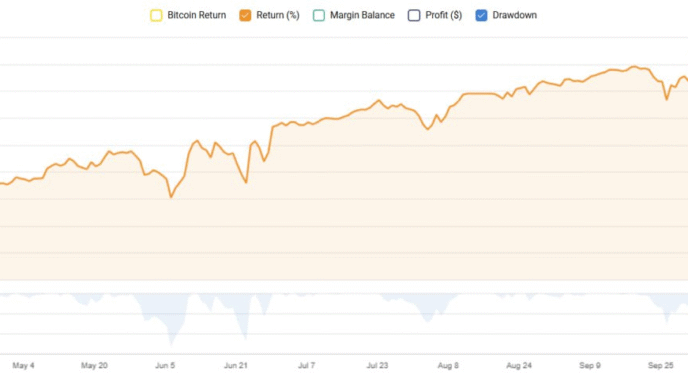The SaaS market is really taking off, and if you’re running a company in this space, you know it’s a wild ride. With so much happening, it’s easy to get lost in all the data. That’s where knowing your financial KPIs for SaaS companies comes in handy. Think of them as your map and compass, showing you where you are and how to get where you want to go. We’re going to look at the key numbers that actually matter for growing your SaaS business in 2025, so you can make smarter choices and actually see your company succeed.
Key Takeaways
- Focus on the metrics that truly show your business’s health, like MRR, CLTV, and churn rate. Regularly checking these helps you figure out what’s working and what’s not.
- Don’t just collect data; use it. Visualizing your key financial KPIs for SaaS companies on dashboards helps you spot trends and make smart moves for growth.
- Your business changes, so your KPIs should too. Keep reviewing and adjusting your targets to make sure they still make sense as you grow.
- Set realistic goals for your KPIs by looking at your own past performance and what other companies in your industry are doing.
- Understanding the core financial KPIs for SaaS companies is vital for making good decisions about marketing, sales, and keeping customers happy.
Understanding Essential Financial KPIs for SaaS Companies
Running a SaaS company feels like a constant balancing act, doesn’t it? You’re trying to grow, keep customers happy, and, you know, actually make money. It’s a fast-paced world out there, and the global SaaS market is huge, projected to hit $10 trillion by 2030. With all that going on, just guessing how you’re doing isn’t going to cut it. That’s where Key Performance Indicators, or KPIs, come in. Think of them as your financial dashboard, showing you what’s working and what’s not.
Why Financial KPIs Are Crucial for SaaS Growth
So, why bother with all these numbers? Well, in the SaaS world, success isn’t just about having a cool product. It’s about predictable income, keeping customers around, and spending your money wisely to get new ones. Financial KPIs give you a clear picture of your business’s health. They help you see beyond just the surface and understand the real economics driving your company. Without tracking the right metrics, you’re essentially flying blind. This is especially true because SaaS businesses have unique financial patterns, like recognizing revenue over time instead of all at once, and often spending a lot upfront to get new customers.
Defining Key Performance Indicators in the SaaS Context
What exactly are these KPIs in the SaaS world? They’re measurable data points that tell you how your business is performing. Unlike general business metrics, SaaS KPIs are tailored to subscription models. They look at things like:
- How much money you’re making from subscriptions each month.
- How much it costs to get a new customer.
- How long customers tend to stick around.
- How happy your customers are.
These aren’t just random numbers; they’re indicators that help you make smart decisions about where to invest your time and money. For instance, understanding your Customer Acquisition Cost (CAC) is vital for knowing if your marketing spend is paying off.
Navigating the Dynamic SaaS Market with Data
The SaaS market changes constantly. New competitors pop up, customer needs shift, and technology evolves. Relying on gut feelings just won’t work anymore. KPIs act as your guide, helping you adapt and stay competitive. By regularly checking these metrics, you can:
- Identify areas where you’re excelling.
- Spot problems before they become major issues.
- Make informed decisions about pricing, marketing, and product development.
This data-driven approach is what separates the companies that grow steadily from those that struggle. It’s about using facts to steer your business toward sustainable success.
Core Revenue and Profitability Metrics
When you’re running a SaaS business, just looking at total sales numbers doesn’t tell you the whole story. You need to dig a bit deeper to see where the real money is coming from and if you’re actually making a profit on your services. It’s like checking your bank account – you see the total, but you also need to know what’s coming in and what’s going out, and if the incoming is more than the outgoing.
Monthly Recurring Revenue (MRR) Mastery
MRR is the heartbeat of most SaaS businesses. It’s the predictable income you expect to get every month from your subscriptions. Think of it as your baseline income. Calculating it is pretty straightforward: you take the total revenue from all your active subscriptions in a given month. This metric is super important because it shows how stable your income is and helps you forecast future earnings. A steady or growing MRR means your business is on solid ground.
Annual Recurring Revenue (ARR) for Predictable Growth
ARR is basically MRR multiplied by 12. It gives you a yearly view of your predictable income. While MRR is great for day-to-day operations and short-term planning, ARR helps you look at the bigger picture and plan for longer-term growth. Investors often look at ARR because it shows the scale and stability of your business over a full year.
Understanding Gross Margin for Service Efficiency
Gross margin tells you how much money you have left from your revenue after you’ve paid for the direct costs of providing your service. These direct costs, often called Cost of Goods Sold (COGS) in SaaS, can include things like:
- Hosting and server costs
- Third-party software licenses that are part of your product
- Salaries for customer support and implementation teams
If your gross margin is high, it means you’re efficient at delivering your service. A common target for healthy SaaS companies is a gross margin of 80% or more. If it’s low, you might be spending too much on infrastructure or support, which eats into your profits before you even consider sales and marketing expenses.
Customer Acquisition and Lifetime Value Metrics
It’s easy to get caught up in just bringing new customers in the door. You might be spending a lot on ads, running webinars, and generally trying to get as many sign-ups as possible. But if you’re not looking at the bigger picture, you could be spending way more than you’re getting back. That’s where understanding how much it costs to get a customer and how much they’re worth over time really matters.
Calculating Customer Acquisition Cost (CAC)
So, what’s the deal with CAC? Simply put, it’s the total amount of money you spend to get a new customer. Think about all your marketing and sales expenses – ad spend, salaries for your sales team, software tools, even the cost of that fancy coffee you buy during client meetings. You add all that up for a specific period and then divide it by the number of new customers you gained in that same period. Knowing your CAC helps you see if your marketing and sales efforts are actually paying off. If your CAC is too high, you might be burning through cash without a solid return.
Here’s a basic way to think about it:
- Total Sales & Marketing Costs: All expenses related to acquiring customers.
- Number of New Customers Acquired: The count of new customers during that period.
CAC = Total Sales & Marketing Costs / Number of New Customers Acquired
Maximizing Customer Lifetime Value (CLTV)
Now, let’s talk about CLTV, or Customer Lifetime Value. This metric tries to predict the total amount of money a customer will spend with your company from the moment they sign up until they eventually leave. It’s not just about their first purchase; it’s about their entire relationship with you. A higher CLTV means customers are sticking around and spending more over time, which is great news for your business’s long-term health.
To figure out CLTV, you generally look at:
- Average Purchase Value: How much a customer typically spends per transaction.
- Average Purchase Frequency: How often they buy from you.
- Average Customer Lifespan: How long they stay a customer.
CLTV = Average Purchase Value * Average Purchase Frequency * Average Customer Lifespan
(Note: For SaaS, this often gets more complex, factoring in subscription value and churn rates, but this gives you the core idea.)
The Strategic LTV-CAC Ratio for Sustainable Growth
This is where things get really interesting. Just knowing your CAC and CLTV isn’t enough. You need to see how they relate to each other. That’s where the LTV-CAC ratio comes in. It compares how much a customer is worth to you over their lifetime versus how much it cost you to get them in the first place.
| Metric | What it Measures | Ideal Scenario | Why it Matters |
|---|---|---|---|
| LTV-CAC Ratio | The relationship between customer lifetime value and acquisition cost | 3:1 or higher | Shows if you’re making more from customers than you spend to get them. |
If your LTV is significantly higher than your CAC (a ratio of 3:1 or more is often considered healthy), it means your customer acquisition strategies are working well and you’re building a profitable business. If the ratio is low, or even below 1:1, you’re likely spending too much to acquire customers and need to rethink your approach. It’s all about making sure each customer you bring in contributes positively to your bottom line over the long haul.
Customer Retention and Engagement Indicators
Okay, so we’ve talked about getting customers in the door, but what about keeping them happy and sticking around? That’s where retention and engagement metrics come in. Honestly, it’s way cheaper to keep a customer than to find a new one, so paying attention here is a no-brainer.
Monitoring Churn Rate for Customer Loyalty
Churn rate is basically the percentage of customers who decide to leave you over a certain period. If you start the month with 200 customers and 15 of them cancel, that’s a 7.5% churn rate. High churn can really mess with your growth plans, making it feel like you’re constantly refilling a leaky bucket. It’s a big signal that something might be off – maybe the product isn’t hitting the mark, customer service is slacking, or the price just isn’t right. Keeping an eye on this number helps you spot problems early. You can also look at revenue churn, which focuses on the actual money lost from cancellations, not just the number of customers. For SaaS, tracking recurring revenue churn is especially important because it shows the health of your subscription income.
Leveraging Customer Engagement Scores (CES)
Customer Engagement Score (CES) is a way to put a number on how much people are actually using your product. It looks at things like how often they log in, what features they use, and how deeply they interact with your service. A higher score usually means customers are getting more value and are less likely to leave. Think of it as a health check for your product’s stickiness. Companies that do well here often have a shorter Time-to-Value (TTV), meaning new users figure out how great your product is really fast. This is key for turning trial users into paying customers.
Here’s a quick look at how some engagement metrics might stack up:
| Metric | Early Stage | Growth Stage | Mature Stage | Industry Average |
|---|---|---|---|---|
| DAU/MAU Ratio (Stickiness) | 10-15% | 15-25% | >25% | ~20% |
| Feature Adoption Rate | >30% | >40% | >50% | ~40% |
| Time-to-Value (TTV) | < 1 hour | < 30 minutes | < 15 minutes | Varies |
Remember, these are just general ideas. Your own numbers will depend a lot on what you sell and who you sell it to.
The Power of Net Promoter Score (NPS) for Referrals
Net Promoter Score (NPS) is pretty simple: it asks customers how likely they are to recommend you to a friend. It’s a great way to gauge overall satisfaction and loyalty. Happy customers who give high NPS scores are your best source of new business through word-of-mouth. By understanding who your promoters are and why they love you, you can encourage more referrals and reduce churn. It’s a direct line to understanding how much people actually like what you’re doing, which is pretty important if you ask me. Focusing on customer retention rate is often more cost-effective than constantly chasing new leads.
Advanced Financial Health and Efficiency Benchmarks
Growth is great, but is it smart growth? That’s where these advanced benchmarks come in. They help you see if your company is just spending a lot to get bigger, or if it’s building a solid foundation for the long haul. Investors and smart leaders look at these because they show the real health of the business, not just a temporary sales bump.
Applying the Rule of 40 for Balanced Growth
The Rule of 40 is a simple but powerful way to check if your growth and profitability are in sync. The idea is that your annual revenue growth rate plus your profit margin should add up to at least 40%. For example, if your company is growing at 30% per year, you’d want a profit margin of at least 10% to hit that 40% mark. If you’re growing faster, say 50%, your profit margin can be lower, maybe even negative if you’re reinvesting heavily. It’s a quick check to see if you’re growing sustainably.
- High Growth, Lower Profit: If your growth rate is very high (e.g., 60%), your profit margin can be lower (e.g., -20%) and still meet the 40% target. This is common for startups focused on market share.
- Moderate Growth, Solid Profit: A company growing at 20% would need a 20% profit margin to reach 40%.
- Low Growth, High Profit: If growth slows to 10%, you’d need a 30% profit margin to stay healthy by this rule.
Optimizing Lead-to-Customer Conversion Rates
This metric tells you how good your sales and marketing teams are at turning interested people (leads) into paying customers. It’s not just about getting a lot of leads; it’s about getting the right leads and having a smooth process to close them. A low conversion rate might mean your marketing is attracting the wrong audience, or your sales pitch isn’t hitting the mark. Improving this means more revenue from the same marketing spend.
Here’s a look at how different stages might perform:
| Stage | Typical Conversion Rate | Focus Areas |
|---|---|---|
| Early Stage | 3-5% | Refining lead qualification, improving sales scripts |
| Growth Stage | 5-10% | Optimizing sales process, better lead nurturing |
| Mature Stage | 10%+ | Sales team efficiency, advanced closing techniques |
Analyzing Monthly Active Users (MAU) for Product Stickiness
Monthly Active Users (MAU) shows how many unique people actually use your product in a given month. It’s a key indicator of whether people find your product useful enough to come back regularly. A growing MAU suggests your product is sticky and solving a real problem for your customers. If MAU is flat or declining while you’re acquiring new customers, it might mean those new customers aren’t sticking around, which can be a red flag for future revenue.
- What it measures: Unique users interacting with your product.
- Why it matters: Shows product value and retention.
- What to watch for: Trends over time, especially in relation to new customer acquisition.
Implementing and Monitoring Financial KPIs Effectively
So, you’ve picked out the key financial metrics that matter most for your SaaS business. That’s a great start, but honestly, just knowing them isn’t enough. You’ve got to put them to work and keep an eye on them. It’s like having a car – you need to check the oil and tire pressure regularly, not just when something feels off.
Setting Realistic KPI Targets with Benchmarks
First things first, don’t just guess what a good number looks like. You need to set targets that are actually achievable. This is where benchmarks come in handy. Think of them as a way to see how you stack up against other companies in the SaaS space. You can find this kind of info in industry reports or from financial analysts. For example, looking at data from places like SaaS Capital can give you a solid idea of what’s normal. But remember, these are just starting points. Your own business is unique, so you’ll want to tweak those targets based on where you are, how fast you’re growing, and what your specific goals are. If you’re a brand new startup, aiming for massive MRR growth might be the focus, while an older company might care more about getting more value from each customer compared to what it cost to get them.
Utilizing Historical Data for Accurate Projections
Looking back at your own company’s past performance is super important for figuring out where you’re headed. Your own history is often the best predictor of your future. If your Monthly Recurring Revenue has been climbing by about 5% each month, setting a goal of 10% next month might be a bit of a stretch. It’s usually better to aim for steady, incremental improvements. This approach helps keep your team motivated and avoids setting them up for disappointment. By analyzing past trends, you can make more educated guesses about what’s likely to happen next, which helps in planning and resource allocation. It’s about building a realistic roadmap based on what you know has worked before.
Building Dashboards for Actionable Insights
Okay, so you’ve got your targets and you’re tracking your progress. Now, how do you make sense of all that data without getting overwhelmed? Dashboards are your best friend here. They take all those numbers and put them into a visual format that’s easy to understand at a glance. This isn’t just for the CEO; sharing these insights across your teams can really help everyone understand how their work impacts the bigger picture. When people see how their efforts connect to the company’s goals, they tend to be more engaged. A good dashboard should show you what’s going well, what needs attention, and help you spot problems before they get too big. It’s about turning raw data into clear actions. If you’re struggling with how to manage your data effectively, consider looking into solutions that can help streamline this process, like those offered by HubiFi data management solutions.
Regularly checking in on your KPIs and making adjustments based on what the data tells you is how you keep your SaaS business on the right track. It’s an ongoing process, not a one-time thing.
Wrapping It Up: Your Financial Compass for SaaS Success
So, we’ve talked about a bunch of numbers – MRR, CAC, LTV, churn, and all those other acronyms. It might seem like a lot, but honestly, these aren’t just random figures. They’re like the dashboard lights in your car; ignore them, and you might end up stranded. Keeping an eye on these financial markers is how you steer your SaaS company toward steady growth and avoid costly mistakes. The market’s moving fast, and staying on top of these metrics means you can make smarter choices, keep customers happy, and actually make money. It’s not about chasing every shiny new trend, but about understanding what’s really working for your business. So, get these numbers in front of you, look at them regularly, and use them to guide your next steps. Your future self will thank you.
Frequently Asked Questions
What exactly are SaaS financial KPIs and why are they so important?
Think of SaaS financial KPIs as your company’s report card, but for money matters. They are special numbers that show how well your business is doing financially. For Software as a Service (SaaS) companies, which make money from subscriptions, these numbers are super important because they tell you if you’re making enough money from customers, if you’re spending too much to get new customers, and if your customers are happy and sticking around. Knowing these things helps you make smart choices to grow your business.
What is Monthly Recurring Revenue (MRR) and why should I care about it?
Monthly Recurring Revenue, or MRR, is the money your company expects to get every month from its subscriptions. It’s like a steady paycheck for your business. Caring about MRR is vital because it shows you if your business is growing predictably. If your MRR is going up each month, that’s a great sign! It means more people are signing up for your service or staying subscribed.
How do I know if I’m spending too much to get new customers?
This is where the Customer Acquisition Cost (CAC) comes in. It’s the total amount of money you spend to get one new customer. To figure out if it’s too much, you compare it to how much money that customer will likely bring you over time (that’s called Customer Lifetime Value or CLTV). If your CAC is much higher than your CLTV, you’re spending more than you earn from that customer, which isn’t good for long-term success.
What is churn rate and why is it a big deal for SaaS companies?
Churn rate is simply the percentage of customers who stop using your service or cancel their subscription within a certain time. It’s a big deal because losing customers costs you money and growth. If your churn rate is high, it means many people are leaving, and you’ll constantly have to work extra hard to find new ones just to stay in the same place. Keeping customers happy and reducing churn is key to steady growth.
What’s the ‘Rule of 40’ and how does it help my business?
The Rule of 40 is a simple guideline for SaaS companies. It says that your business’s growth rate plus its profit margin should add up to at least 40%. For example, if your business is growing at 30% per year, you should aim for a profit margin of at least 10%. This rule helps you balance growing fast with making sure your business is actually making money, showing it’s healthy and can last.
How can I use historical data to set good goals for my KPIs?
Your past performance is like a cheat sheet for setting future goals. By looking at your own numbers from previous months or years, you can see what worked well and what didn’t. This helps you set goals that are realistic and achievable, rather than just guessing. For instance, if your MRR has grown by 5% each month for the last six months, setting a goal of 6% growth for the next month is a reasonable target based on your history.














